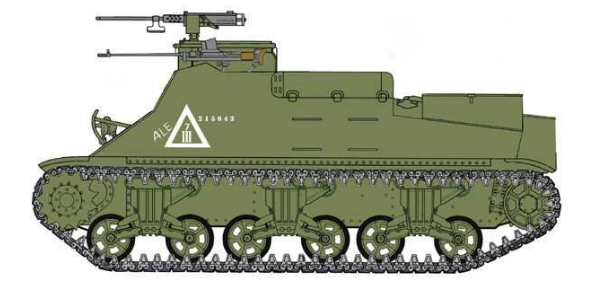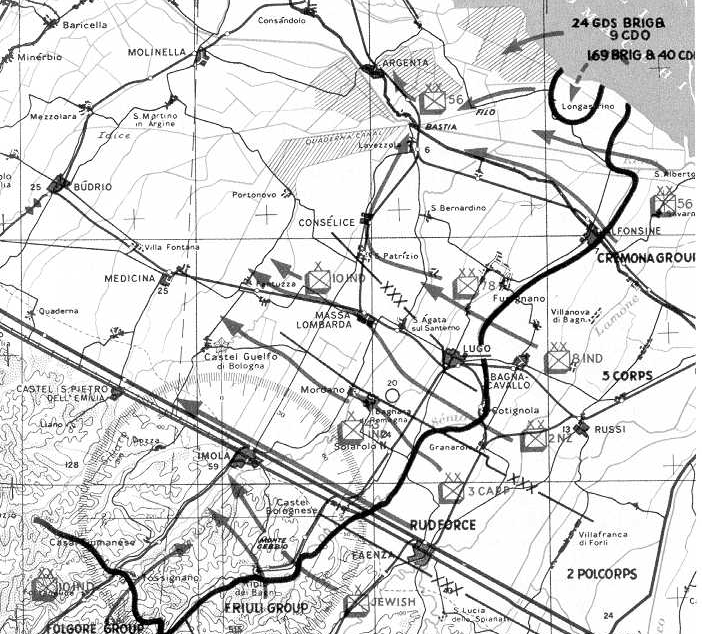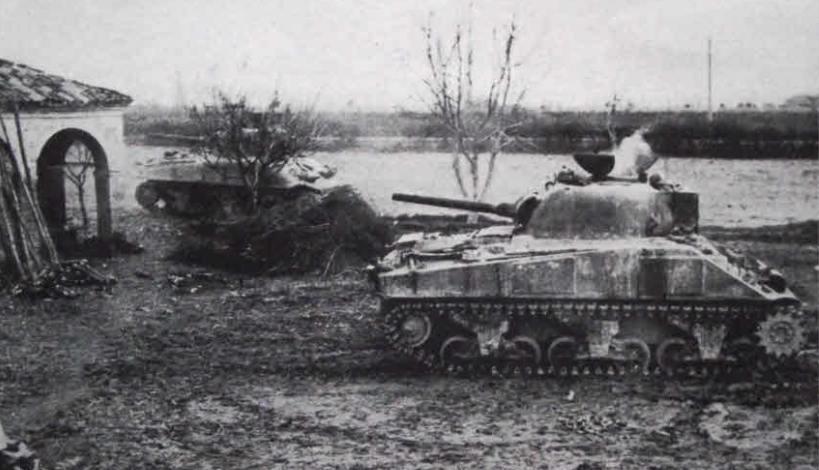Spring Time in Italy
New year 1945
Tracking the events that preceded the start of the new year 1945 I can take a geographical pot shot that Grandad was at this time somewhere around the Emilia-Romagna town of Faenza. At this location the river Senio formed the front line between Axis and Allied forces, one that remained fairly static until the April spring offensive. I say static but the new year did start with a local offensive to ‘tidy-up’ the line involving elements of 7th armoured brigade.
In the main at the start of January German forces occupied the line North of the river, however there were exceptions to this. One such exception was the tract of land South East of the town of Bagnacavello and North of Faenza. It was here on 3rd January that operation Cygnet was launched to clear the lodgement. 2nd Royal tanks of 7th armoured with 10th Royal Hussars led a battle group that took the town of Granarolo. Infantry support was provided by 2/6th Queens battalion from 169th brigade , 56th division. Flexible close support provided by the infantry was aided by the use of Kangaroo armored personnel carriers. The Kangaroo was basically a Sherman tank minus turret that could carry an infantry section. The advantages gained by the use of APC’s including speed of advance gave the Queensmen the element of surprise and many prisoners were taken in this action.

Trench warfare
Although there was to be a 3 month pause before large scale active operations were to start again, life on the front line was never entirely quiet. With opposing forces dug in for the duration conditions for the infantrymen were not far removed from those experienced by the preceding generation in the first world war. Both sides became practitioners of local small scale operations. Patrols , raids and harassing fire were the order of the day. There was certainly no attitude of turning a blind eye in the hope of a quiet life in return, something practiced by either side.
With Grandad being a member of the brigade signal squadron I suspect he would not have been static in any one location during these months around Faenza? Indeed, as units of the brigade would have been rotated in and out of the line, communications would still have needed to be maintained between them. His role still would have been an active one, not only as the forward line needed to be maintained with adequate communications but also because preparations were underway for the coming offensive, including training and conversions.
He could have been lucky enough to be posted away from the frontline back in Forli for a few weeks when elements of the brigade were converting from Sherman to Churchill tanks? This conversion took place in January / February and might be one reason Grandad was allowed leave to be in Rome at that date, as a photograph in his old wallet documents. I’ll never know for certain his exact dispositions during these months? I can only gain the slightest of insights.
With the approach of Spring this ‘static’ trench warfare would end.
Operation Buckland
I can remember Grandad saying when in Italy he had fought alongside Polish troops. At the time I had visions of him at Cassino as I had read about the exploits of Polish forces at this famous battlefield. What I didn’t appreciate was that Cassino was just one of a series of battles the Poles had taken part in during the campaign in Italy. Their story , like the rest of the 8th Army in the Italian campaign, was one of a long hard slog. There was also the fact that at the time of Cassino Grandad was still in North Africa. The Poles certainly were present for the Spring offensive, as was Grandad , being a member of 7th Armoured Brigade.
On the eve of operation Buckland ,the code name for the 8th Army’s contribution to operation Grapeshot , the Polish 2nd Corps sat astride Route 9, the main road to Bologna. During March, 7th Armoured along with the 43rd Gurkha brigade were attached to this Corps under Polish command to provide support for the coming offensive. This is obviously the time Grandad was referring to.

A tragic start
Operation Buckland commenced on April 9th with a massive aerial bombardment. Some 825 B-17 and B-24’s dropped 125,000 fragmentation bombs on the German artillery and reserve lines opposing the assaulting formations of 8th Army. On the Polish Corp front this led to friendly fire casualties when American bombers dropped their ordinance on the units forming up for attack. This tragic incident could be the origin for the story Grandad told of surviving being bombed? He described a tale of watching aircraft flying over and seeing the bombs fall. He said he dived under the nearest truck and pressed as hard as he could into the mud . This presence of mind saved his life, for those who ran were killed. After the event he told of pulling one of the wounded from mud to find that both of his legs had been cut off below the hip. He said the poor chap was dead in minutes. The story continued that he was taken to an aid station with suspected blast concussion. Not happy being separated from his unit Grandad said he decided to attempt to rejoin them. This was achieved by hitching a lift on a ‘Yank’ truck that had an obliging driver.
I’d always assumed that the protagonists of Grandad’s story were the Luftwaffe. This was always problematic as at this stage in the war German aircraft were largely absent from the skies above North Italy. I can now place Grandad at a time and location where a tragic incident of friendly fire took place. One Polish battalion alone suffered 160 casualties. Armed with this knowledge it seems likely that his story is indeed related to this event and unfortunately the airmen were not from Germany.
Despite the bombing the Poles were not delayed in their attack. However they found the approach to river mined, which slowed progress. By the next morning , the 10th they had two brigades across the Senio. Resistance was tough. Opposing them was 26th Panzer. This unit put up a tough fight, but by the 11th the Poles had reached the next river, the Santerno.
Online I had read that units from 7th Armoured had been in action around the town of Lugo. I found this a little confusing as this would have involved the various tank regiments participating crossing the 2nd Polish Corps boundary into the area designated to 5th Corps. They would then have been fighting alongside elements of the 2nd New Zealand division , 78th division and perhaps even the 8th Indian division, this being the disposition of the stated units running from West to East. This geographical disparity was solved by a quick look through a book in my collection, ‘ Armoured Odyssey’ by Stuart Hamilton, 8th Royal Tank Regiment ( an excellent read). In his book Mr Hamiliton quotes directly from another source ‘The Tanks’ by Captain Liddell Hart which explains the situation on the 10th :
‘The crossings of the Senio on the Polish Corp front were so hotly opposed that after 24 hours delay, some of the tanks allotted to co-operate with it had to be sent across by Bailey Bridge thrown across over on a New Zealand Division sector further north. The 6th RTR then went across the Lugo canal south of that town whilst the 8th RTR on its left assisted the Polish infantry in the capture of Solarolo and both then reached the Santurno river on April 11th and crossed it to bring much needed help to the infantry hard pressed on the further banks ‘

Onwards to Bologna
The advance towards Bologna continued . Imola was liberated next with the Poles crossing the Sillaro on the night of 15th/ 16th. During the following night 2nd RTR supported 43 Gurka Brigade who took the town of Medicina. In his book Major Hamiliton records 8 RTR cutting the main Bologna Ferrara road east of Bologna on April 19th at a place called Castel Maggiore. Despite the tough opposition put up by the soldiers of the 1st Parachute Rifle Division, it was men from the 3rd Carpathian Division that entered the city first on the 21st . When he roared into Bologna with a pal that particular day, Major Hamilton attests to being one of the first British officers into the city.
Organised German resistance from this point onwards South of the river Po started to crumble. On May 2nd what was left of German forces in Italy surrendered. At this time 8 RTR was around the region of Minerbio on the main Bologna – Ferrara road as recorded by Major Hamiliton. From another source the war diary of 6 RTR records the regiments’ move to an area South East of Padua on 4th May, not far distant from Venice . Indeed Grandad was in this city on the 6th as a documented picture of the Grand Canal from his wallet attests. The war diary also documents that on the 15th May a thanksgiving service was held at 8 RTR HQ. I have in possession the service sheet that was handed to my Grandad at this event. The next entry in the war diary records that the commanding officer of 6 RTR left on a reconnaissance trip to Austria. This was to be Grandad’s next destination, which is the next stage in his story.

